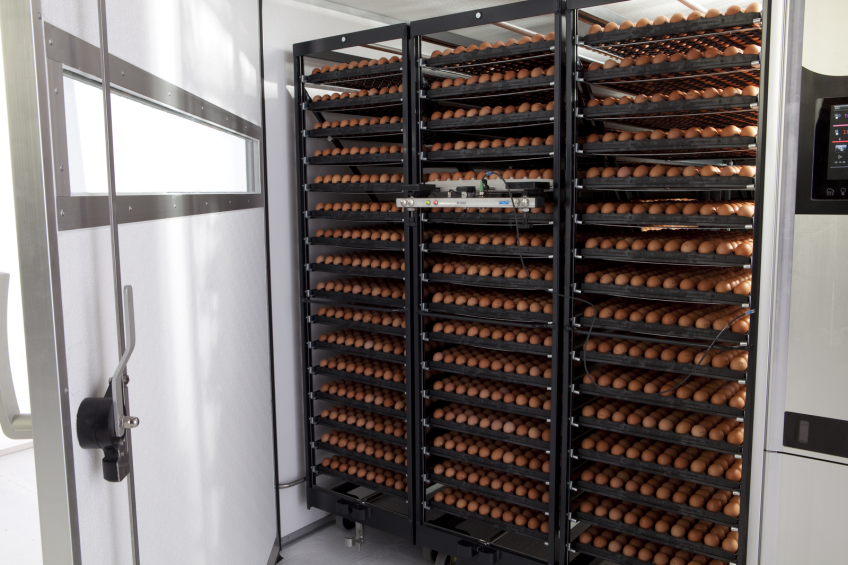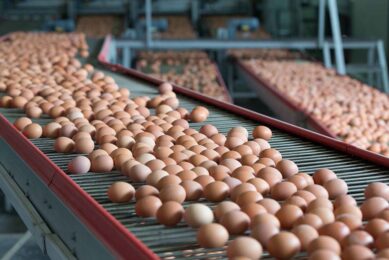The benefits of non-linear weight loss

One of the main benefits of single-stage incubation is the possibility to apply the non-linear weight loss system, in which ventilation is reduced during the first nine days in the setter and increased during the next nine days.
With eggs at various stages of development at any point in a multi-stage setter, ventilation levels should always be such that the CO2 and O2 levels are within safe limits for the most vulnerable eggs. Subsequently, for the sake of the eggs at the exothermic stage of incubation (days 9-18), the ventilation rate is kept high. As a result, natural humidity levels will be very low. The eggs will lose too much water (and weight) and therefore, artificial humidification needs to be added to limit the water loss. Moreover, as the ventilation rate is high, most of the injected humidification is exhausted quickly so the injection needs to be constant and at a relatively high rate.
However, any method used to inject artificial humidity disrupts the internal environment and often brings about an added bio-security risk. In order to keep the environmental disruption and additional bio-security risk to a minimum, the weight loss rate should be brought down to the highest acceptable percentage, targeting a weight loss of 11-12% by transfer time (day 18). This makes it possible to limit the use of artificial humidification in the setter but requires a high degree of humidification in the hatcher.
Humidity levels
Single-stage incubation allows controlling the ventilation rates more precisely, eliminating the need to humidify artificially during the incubation process (humidification is only applied after completion of the hatch in the hatcher, to ensure that the chicks remain hydrated).
Firstly, the target weight loss at day 18 (time of transfer to the hatcher) can be reduced to 10-11% instead of 11-12% in multi-stage incubation. Secondly, the concept of non-linear weight loss (NLWS) can be applied. During the first 9 days of incubation, ventilation rates are reduced, allowing for a natural build-up of humidity and a reduced rate of weight loss. Between days 9-18, ventilation is intensified to reduce humidity levels and boost water (weight) loss, in order to achieve the target of 10-11% by transfer to the hatcher.
Figure 1 compares multi-stage to single-stage (NLWS) ventilation rates and the associated weight loss profiles (ventilation rates after transfer have been omitted as ventilation activity varies greatly in order to stimulate hatch). The graph shows that the multi-stage system produces a linear weight loss profile, whereas the NLWS system creates a non-linear profile. The NLWS curve directly relates to the heat production curve and the oxygen requirements of the developing embryo. The weight loss achieved with NLWS at transfer (day 18) is lower than with multi-stage incubation, but is the same at “point of hatch” (day 20).
Key benefits of NLWS
- No artificial humidification is required in the setter.
- The lower target weight loss at transfer allows for a higher ventilation rate in the hatcher with no artificial humidification needed. In multi-stage systems, artificial humidification in the hatcher is necessary to limit any further weight loss.
- There is no added bio-security risk and no waste of water due to artificial humidification.
- The internal environment of the incubator is not disrupted.
- Ventilation rates will be according to the requirements of the developing embryo, offering maximum efficiency in terms of HVAC usage.
Perhaps the most important factor is the resulting gains in hatchability, chick quality/uniformity, and post-hatch performance.
Join 31,000+ subscribers
Subscribe to our newsletter to stay updated about all the need-to-know content in the poultry sector, three times a week. Beheer
Beheer








 WP Admin
WP Admin  Bewerk bericht
Bewerk bericht